Choosing the Best Multilingual CMS
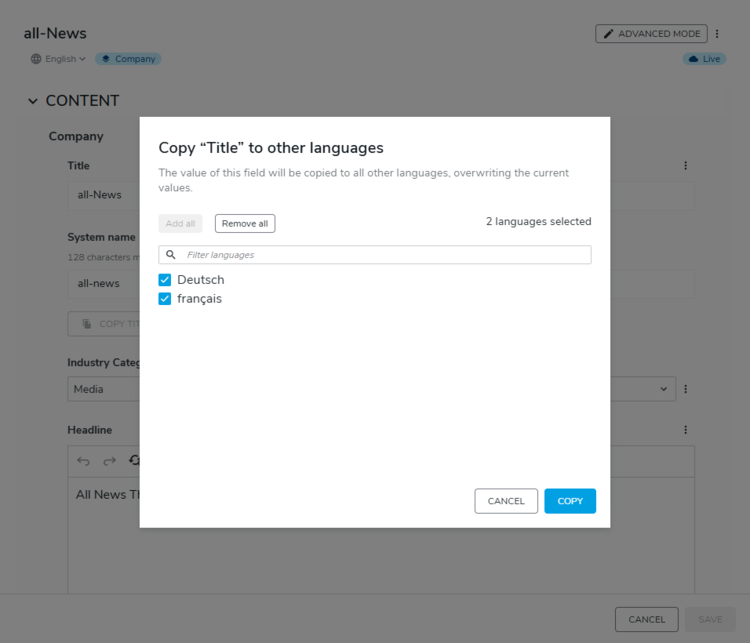
In terms of language management, not all CMS platforms are created equal, far from it. If you're looking for a multilingual CMS platform, since the consequences are significant and it is almost impossible to turn back, here's a list of questions to consider before making your final choice. We've divided these questions into two sections: first those related to the lower layers of the CMS and how languages are managed at the hearth, then questions related to usability and the tools your users should have access to work efficiently.
- Core capabilities and data model -
Granular management of translated and non-translated fields
During the modeling phase, it is crucial to have the ability to easily define which fields are translatable—where content will differ between languages—and which are non-translatable, meaning their values remain consistent across all languages.
This capability saves time and effort by eliminating the need to manually duplicate shared information across languages. For example, elements like product IDs, SKU numbers, or universal terms often do not require translation, whereas descriptive fields, legal disclaimers, or localized content do. Depending on the context and needs, sometimes images, files or links must be the same between languages and sometimes it is imperative that they can vary. Beware that declaring assets internationalized or not-internationalized is not something all CMS handle perfectly.
A well-designed CMS should provide intuitive tools for this differentiation, ensuring a more efficient workflow and reducing the risk of errors when managing multilingual content.
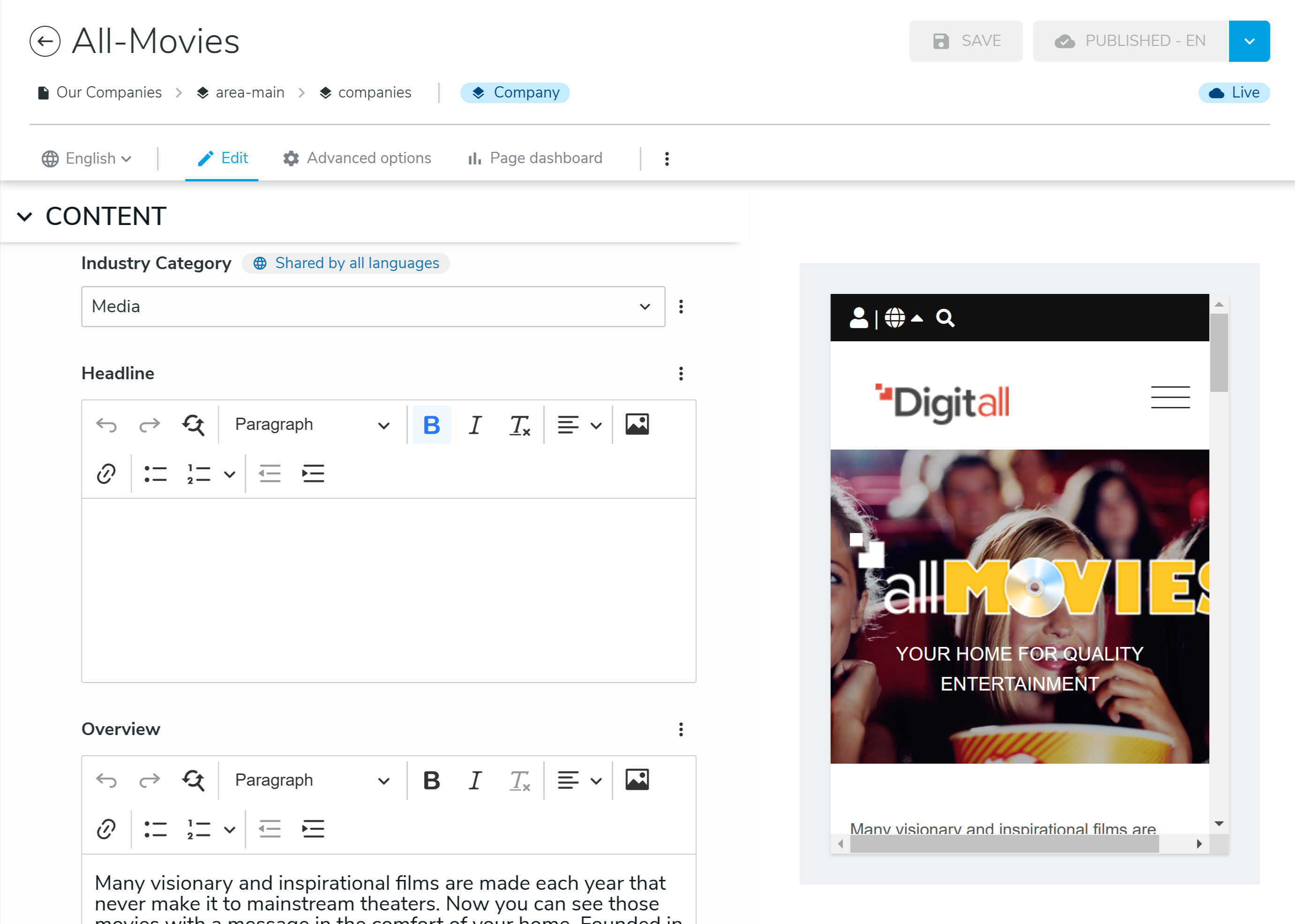
Synchronizing site structure and page content across languages
Maintaining consistency between different language versions of a website is crucial to prevent desynchronization and the publication of conflicting information. To achieve this, your CMS should support mandatory languages in addition to mandatory fields. When a language is marked as mandatory, content or pages cannot be published unless translations for those mandatory languages are completed.
This feature is particularly vital for organizations subject to strict regulatory requirements, such as banks, insurance companies, or publicly traded companies. It also addresses legal obligations in some countries where providing information in multiple languages is required under penalty of significant sanctions.
Conversely, flexibility is equally important. In some cases, it may be necessary to proceed with one language without waiting for translations in others—or to publish specific information in only one language, without ever translating it. For example, additional information might be required for a particular region due to legal mandates (e.g., warnings, disclaimers, or ingredient details) or cultural expectations (e.g., content tailored to local interests that is irrelevant elsewhere).
Enterprise CMS like Jahia can handle both approaches : enforce strict language binding and / or language variations, depending on the needs expressed by the site owner. Most CMS can’t handle that level of complexity.
Managing the lifecycle of each language
Many CMS platforms fail to differentiate between the creation of a language and its activation. In most systems, once a language is added, it becomes immediately available on the website—even if no translations have been completed or entered yet.
At best, some CMS platforms implement a fallback mechanism: if a page is unavailable in a specific language, the system automatically serves the default language version of the page. While this provides a stopgap solution, it often leads to a confusing navigation experience for visitors and can compromise the clarity of the content.
From its inception, Jahia has addressed this issue by decoupling language creation and activation. When a language is created, it becomes accessible to editors and translators for preparation but remains invisible to site visitors. Activation occurs only when the level of translation is deemed satisfactory, at which point the language is made publicly available.
Furthermore, Jahia allows languages to be deactivated at any time, rendering them inaccessible to visitors without losing their content. This capability is invaluable for organizations needing to revisit or revise a language later, or to maintain records for legal or audit purposes. By contrast, in most CMS platforms, deleting a language permanently removes its content, resulting in the loss of potentially critical data.
This nuanced approach ensures both flexibility and compliance, offering precise control over the multilingual lifecycle of a website.

Language management by site rather than at the Platform level
It is important that your CMS allows for language management at the site level rather than as a global platform setting. On a single multisite platform, one site may only be available in two languages, while another might offer four languages, and yet another seven, each with a different default language. Site-level management ensures the ability to meet diverse functional requirements while avoiding unnecessary complexity for the platform.
Language-based rights management
The management of rights and permissions is certainly one of the aspects where CMS platforms differ the most from each other. Some CMS platforms adopt a feature-based approach: the user has the right to edit or not, to delete or not, to publish or not, with or without any regard to the language. Others still manage permissions based on the type of content: a user can create, update, delete "news" content but not "press release" content, regardless of the language. Some manage rights at the page level or for each content item: if a user has the right to edit a piece of content, they usually have the right to edit it in all languages.
However, to meet the needs of large organizations, a more granular approach is often required, if not essential. A good multilingual CMS should be able to define permissions not only by content (or content hierarchy) but also by language and functionality. With this level of granularity, it's possible to define roles with clear and strictly limited permissions tailored to the needs of different stakeholders. For example, in Jahia, a translator role is not strictly the same as an editor role. A standard translator can only translate content, not create new content or delete existing content. Additionally, it should be possible to define that a user with the translator role is a translator for specific languages, but not others. This provides better security (especially if translations are outsourced, as is often the case) and helps maintain cleaner, more user-friendly interfaces.
- Tooling and usability -
Does your CMS support all the languages you need?
At first glance, this might seem like an odd question—after all, isn’t a decent CMS expected to handle multiple languages? However, this consideration is crucial for two key reasons:
- Performance: The number of languages can significantly impact system performance, depending on the underlying data model. Don’t take claims at face value—ask for evidence such as performance tests or feedback from existing customers.
- Usability: Designing interfaces for 2, 3, or even 4 languages is relatively straightforward, as there's usually enough space to display language codes or flags. Though purists argue against using flags as language indicators—but that's a separate discussion.
However, if your team needs to manage more than four languages, it’s essential to thoroughly evaluate whether the interfaces can scale effectively and remain user-friendly. Handling a high number of languages requires a well-designed system to avoid clutter and confusion.
For instance, the European Parliament has been using Jahia for over 15 years to manage content in more than 20 languages—a testament to the importance of choosing a CMS that can handle complex multilingual requirements efficiently.
Side-by-side translations
Most CMS platforms allow users to switch between languages relatively easily. However, this often comes at a cost: the editor or translator loses immediate visibility of the original language. This can result in significant time and effort spent toggling back and forth between languages, increasing the likelihood of errors.
A dual-pane translation interface is a critical feature for effectively managing multilingual sites—unless you plan to handle all translations outside the CMS. With side-by-side translation, editors can compare and edit content in multiple languages simultaneously, ensuring consistency and reducing the risk of mistakes.
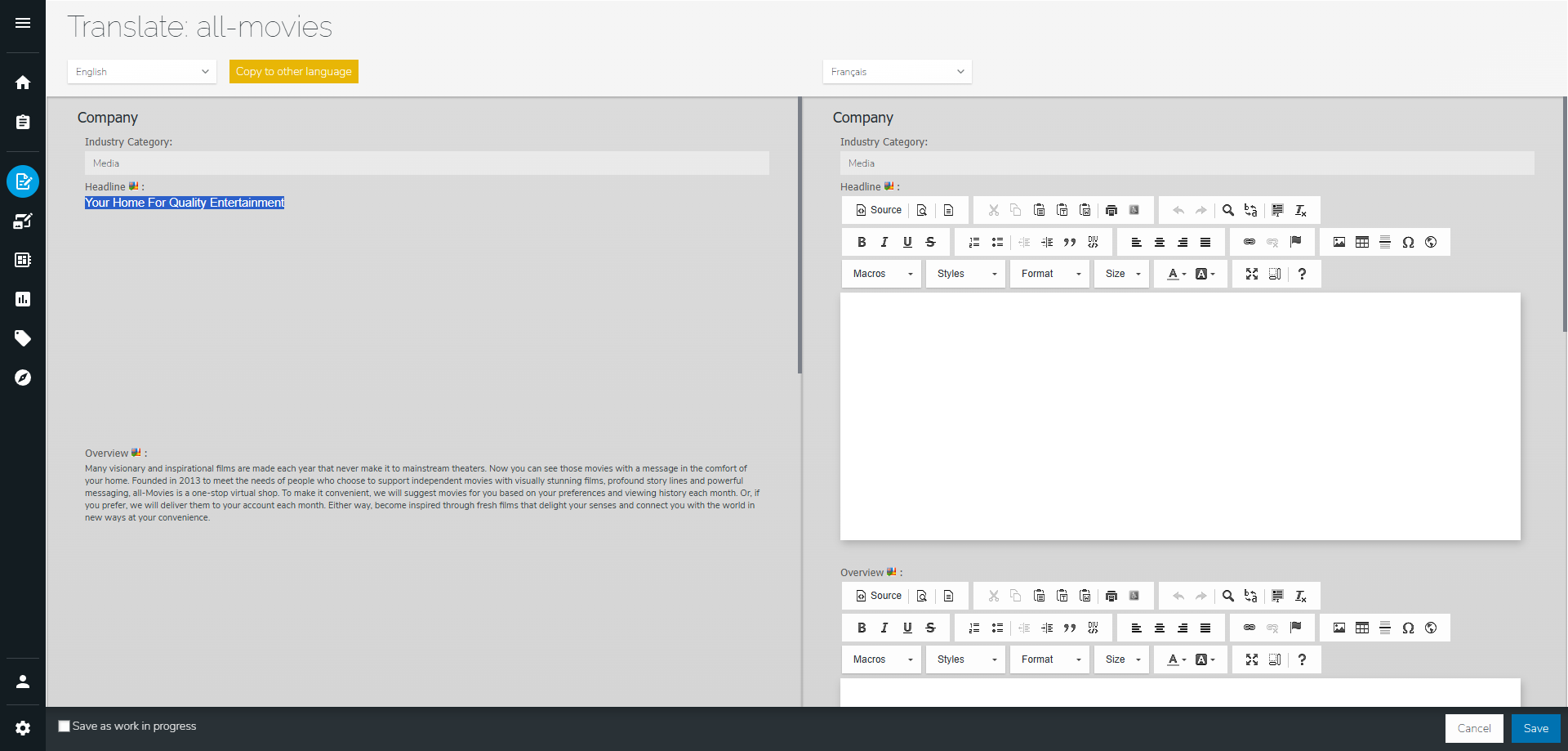
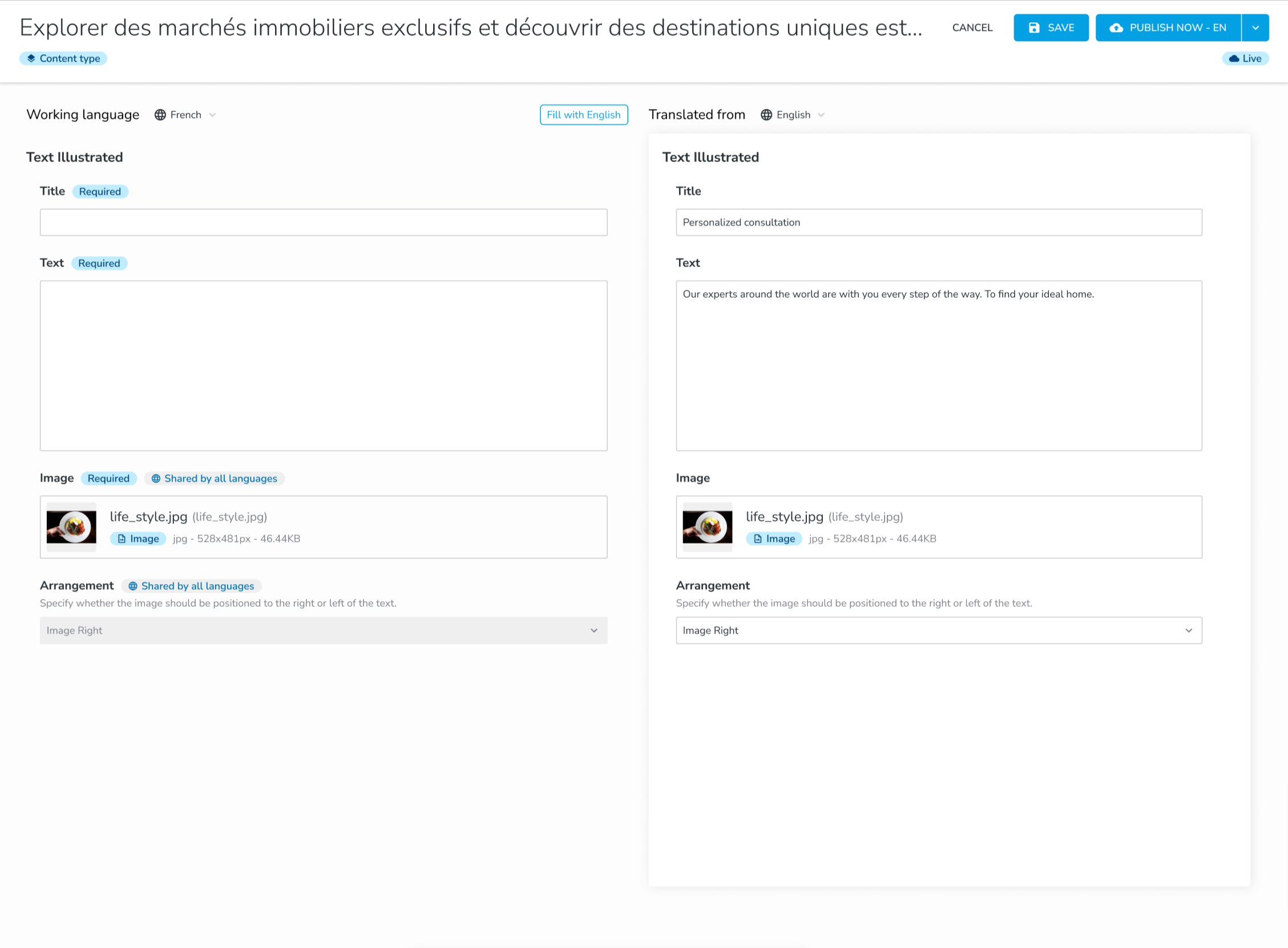
Seamless content exchange between languages
For editors and translators, the ability to effortlessly copy content from one language to another is essential. A streamlined system should allow for a single-click operation to transfer content, whether in push mode (copying content from the current language to another) or pull mode (retrieving content from another language into the current one).
This functionality should be accessible without the need to switch screens or perform complex actions, enabling a more efficient workflow and reducing the risk of errors. A CMS that supports seamless content exchange ensures that your multilingual site remains consistent and easy to manage.


Semi-automatic and automatic translations
Whether it involves an external translation system with human translators, a fully automated solution like Google Translate or Deepl, or even a large language model (LLM), there are many options to handle large volumes of translations, quickly generate a first draft (often literal and imperfect), or produce a higher-quality version ready for publication. A good multilingual CMS should allow integration with these external systems, enabling translations to be sent and retrieved in any language without leaving the tool, thus saving valuable time. A CMS like Jahia offers connectors on the shelf, but you can also easily create your own connector with any system of your choice, leveraging simple to use and integrate APIs.
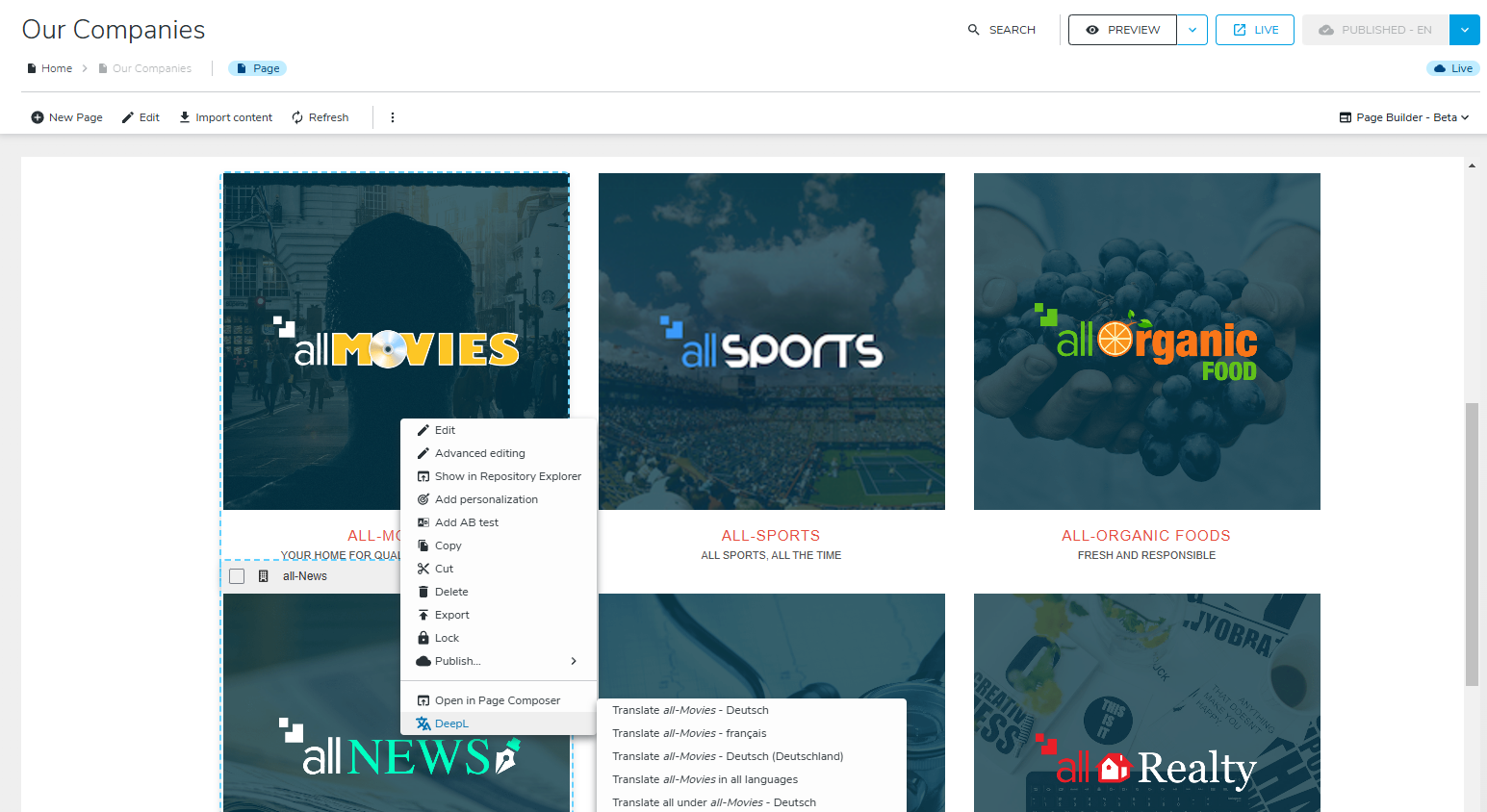
Discover the DeepL integration in Jahia
Conclusion
Choosing an enterprise CMS is complicated and the multilang management capabilities are key. The way languages are handled gives a good idea on how the content model is conceived, if the CMS is robust and scalable.
As managing multiple languages is often complicated and error prone, with possible damages on your team's velocity or your brand image, do not rely on sales demos but ask to talk to existing customers to get their feedback.


